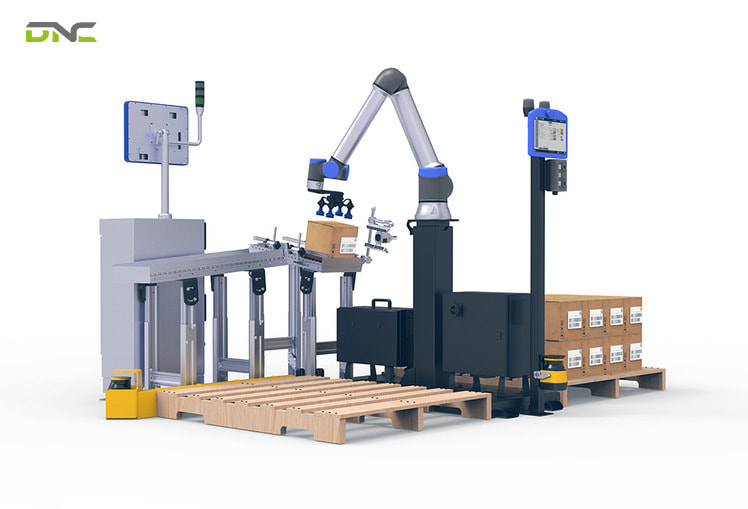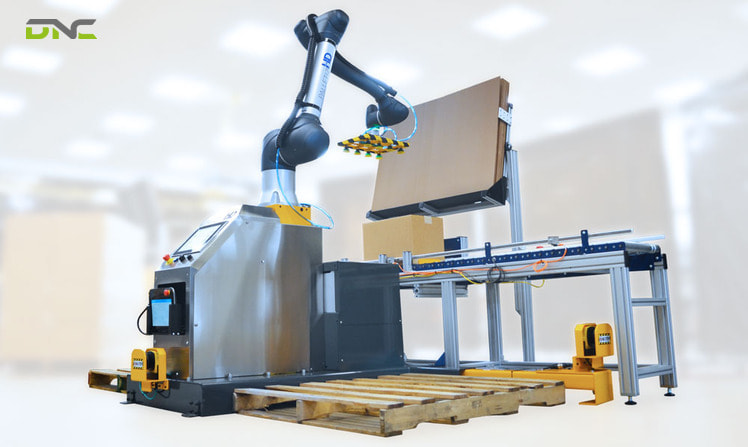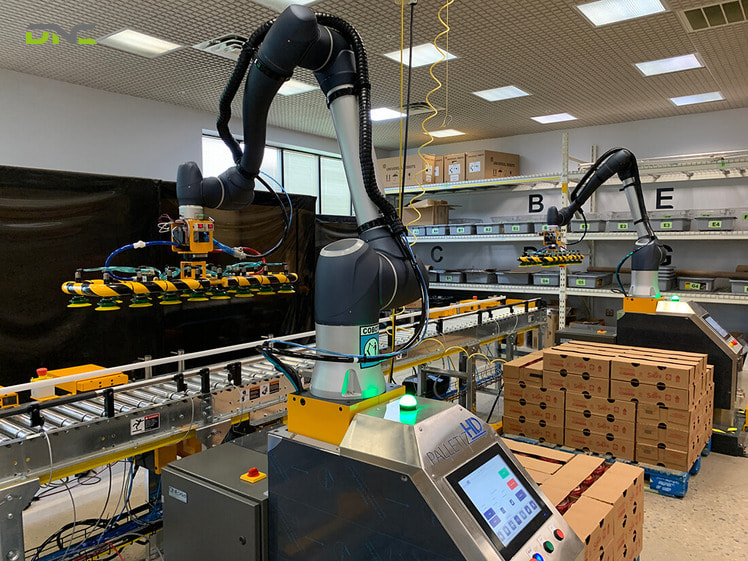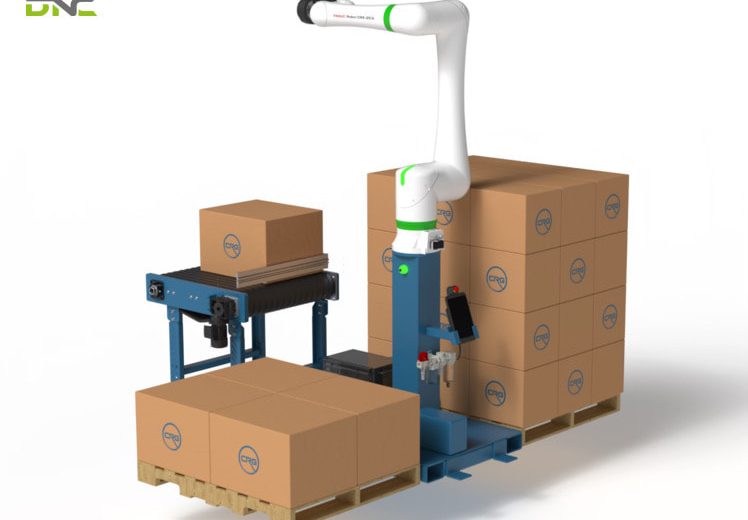Cobot Palletizing: The Future of Smart, Flexible End-of-Line Automation
In the era of agile manufacturing, cobot palletizing represents the perfect balance between human flexibility and robotic precision. Unlike traditional palletizers that require dedicated space and complex safety fencing, collaborative robots (cobots) work safely alongside people — stacking, sorting, and packing products with remarkable ease. As labor shortages intensify and production demands accelerate, manufacturers are turning to cobots for a scalable, cost-efficient automation upgrade.
With proven success in industries like FMCG, food processing, and logistics, cobot palletizing is more than a technology trend — it’s a strategic move toward smarter, safer, and more adaptive production lines.
Introduction: When Collaboration Meets Automation
In modern manufacturing, labor shortages, rising production demands, and the need for agile operations are pushing factories to rethink how they handle repetitive end-of-line tasks. One of the most promising innovations addressing these challenges is cobot palletizing — a collaborative robot solution designed to automate pallet stacking safely and efficiently.
Unlike traditional industrial robots that operate behind safety fences, collaborative palletizing robots (cobots) are engineered to work side-by-side with humans in compact spaces. They offer flexibility, easy reprogramming, and quick deployment, making them ideal for small and medium-sized manufacturers looking to enhance productivity without massive capital investment.
What Exactly Is Cobot Palletizing and How Does It Work?
Cobot palletizing automates the process of stacking boxes, bags, or cartons onto pallets using a collaborative robotic arm equipped with smart vision and gripping technology. The process typically involves a sequence:
- Product detection using a camera or vision system.
- Pick-up with a customized gripper based on box size or material.
- Layer optimization to ensure stable stacking patterns.
- Cycle repeat until the pallet is fully loaded and ready for dispatch.
A complete cobot palletizing system usually includes key components such as:
- Robot Arm: lightweight, collaborative models like UR, FANUC CRX, or ABB GoFa.
- Grippers: vacuum, mechanical, or adaptive types for varied products.
- Vision & Sensors: detect product orientation and ensure accurate placement.
- Safety Features: built-in torque sensors and collision detection for safe human interaction.
- HMI & Software Interface: intuitive programming for quick setup and pattern adjustment.
By combining these technologies, cobot palletizing systems bring a new level of flexibility, safety, and scalability to end-of-line automation — bridging the gap between manual labor and full industrial robotics.

Cobot palletizing automates the process of stacking boxes, bags, or cartons
Cobot vs. Traditional Palletizer — What’s the Difference?
| Criteria | Cobot Palletizer (Collaborative Robot) | Traditional Palletizer (Industrial Robot/System) |
| Operation Concept | Designed to work safely alongside humans without safety cages. Collaborative by nature. | Operates in isolated areas behind safety fences; requires restricted zones. |
| Safety & Compliance | Built-in torque and force sensors detect contact and stop instantly for operator safety. | Requires external safety barriers, light curtains, and fencing for protection. |
| Footprint & Space Requirement | Compact design, suitable for small or constrained spaces. | Larger system with fixed layout and higher space requirements. |
| Flexibility & Reprogramming | Easily reconfigured for different SKUs, pallet patterns, or box sizes. Intuitive drag-and-drop programming. | Requires expert reprogramming and retooling for product changes. |
| Payload Capacity | Typically handles light to medium loads (up to 20–25 kg per pick). | Can handle heavy loads (up to several hundred kilograms) efficiently. |
| Maintenance & Downtime | Simple maintenance; minimal downtime due to modular components. | Requires skilled technicians and planned maintenance intervals. |
| Best Suited For | SMEs, co-packing, and flexible production environments. | Large-scale factories with stable, high-volume output. |
Why Are Manufacturers Switching to Cobot Palletizing?
Manufacturers across industries are rapidly embracing collaborative palletizing as they seek to increase efficiency without overhauling their entire production layout. Cobot palletizers offer a flexible, cost-effective bridge between manual handling and full industrial automation.
- Faster deployment: Cobot palletizers can be installed and operational within days instead of months, minimizing production disruption.
- Reduced changeover time: When switching between SKUs, packaging formats, or pallet patterns, reprogramming can be done quickly through user-friendly interfaces.
- Enhanced workplace safety: Built-in collision detection and force-limiting sensors eliminate the need for bulky safety cages, ensuring safer human–robot collaboration.
- Affordable for SMEs: With lower initial investment and minimal integration costs, cobots provide an accessible automation pathway for small and mid-sized factories.
- Better ergonomics: Cobots take over repetitive and heavy lifting tasks, reducing strain-related injuries and improving employee well-being.

Cobot palletizers offer a flexible, cost-effective bridge between manual handling and full industrial automation.
What Are the Challenges and Limitations of Cobot Palletizing?
While cobot palletizing offers numerous advantages, it’s not a one-size-fits-all solution. Understanding its constraints helps manufacturers make informed decisions before implementation.
- Payload capacity limits: Most collaborative robots handle between 5–25 kg, making them unsuitable for very heavy or bulky products.
- Slower cycle times: Compared to high-speed industrial palletizers, cobots operate at moderate speeds, best suited for low-to-medium throughput lines.
- Structural and layout considerations: Cobot cells require stable flooring, correct pallet positioning, and ergonomic spacing to ensure efficiency and safety.
- Integration challenges: Connecting cobots to older conveyors, labeling systems, or legacy PLCs may require additional interface development.
- Operator skill upgrade: Even though cobots are easy to program, operators still need training in basic robot programming, maintenance, and troubleshooting.

Challenges and Limitations of Cobot Palletizing
How Can You Implement Cobot Palletizing Successfully?
A successful cobot deployment goes beyond installation — it requires planning, simulation, and alignment with production goals. Here’s a proven roadmap for smooth implementation:
- Conduct a site assessment: Analyze production flow, available space, and product variety to identify where automation adds the most value.
- Choose the right cobot and gripper: Select a robot model with appropriate payload, reach, and precision; match it with a vacuum, clamp, or custom gripper for your packaging type.
- Simulate and optimize pallet layouts: Use 3D software to test stacking patterns, layer orientation, and cycle times before real-world deployment.
- Integrate with conveyors, vision, and HMI: Ensure seamless communication across the packaging line through PLC and HMI synchronization.
- Train and pilot: Start with a pilot cell to fine-tune operations, then scale across multiple lines once the setup is validated.
Why Choose DNC Automation as Your Cobot Palletizing Partner?
With a decade of experience in end-of-line automation, DNC Automation stands out as one of Malaysia’s leading integrators for cobot palletizing solutions.
- Proven expertise: 10+ years of success in factory automation, robotics, and material handling systems.
- Turnkey approach: From concept design to simulation, installation, and after-sales support — DNC delivers complete end-of-line automation packages.
- Integration excellence: Seamless connection with conveyors, AGVs, vision systems, and WMS platforms for a unified workflow.
- Local engineering support: Dedicated teams across Malaysia ensure fast response, maintenance, and on-site assistance.
- Industry versatility: Trusted by clients in food processing, FMCG, pharmaceuticals, and electronics manufacturing.
- 0 views
- 0 Comment




Recent Comments